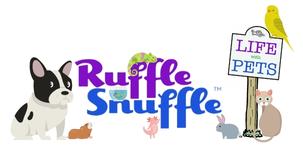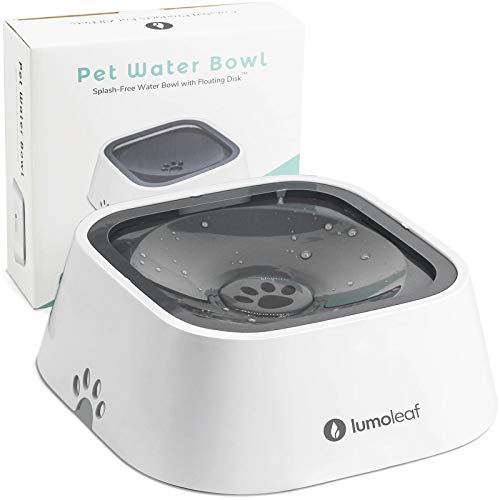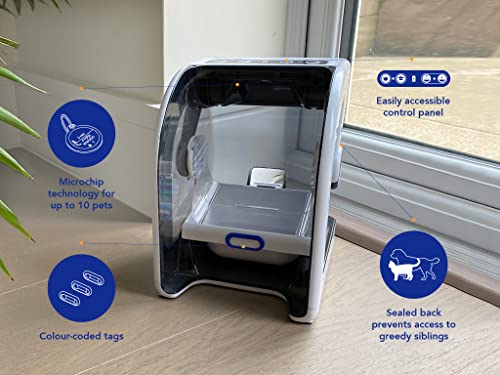If you have a baby and a dog, chances are you’re always on the lookout for ways to make your home safe for both your little one and your furry friend. One area that you might not have thought of is your dog’s food and water bowls these can also pose dangers to your baby’s health. After all, those bowls are usually low to the ground, which makes them the perfect height for curious babies and toddlers to investigate.
Fortunately, there are a few things you can do to baby proof your dog’s bowls. With just a little bit of effort, you can keep your baby safe and your dog well-fed. Read on for seven tips on how to do just that.
What dangers do dog food bowls and water dishes pose to your baby’s health?
The dangers of dog food and water bowls
When it comes to babies and dog food bowls, there are a few dangers to be aware of. Don’t be alarmed though, as they can easily be avoided by following some simple guidelines which I’ll explain below.
So what are the dangers of dog food and water bowls to your baby and child?
Choking: Babies can choke on small pieces of food, so it’s important to take precautions when giving your baby dog food to eat.
Illness: It’s also important to keep baby food and water bowls clean, as bacteria can grow in unclean environments. These bacteria can make your baby sick if consumed.
Injury: Dogs may be food aggressive and react poorly to someone messing with their food, so it’s important to keep your baby away from the bowl when feeding the dog. This will avoid accidentally getting bitten or scratched by the dog.
Drowning: Well, babies can drown in just 1 inch of water, so it’s important to always keep an eye on them around any body of water, including pet bowls in your home.
It’s hard enough to train a toddler to stay away from dog bowls, yet alone a baby. But it’s something you must do, for both the safety of your child and your dog. By starting early and being consistent, you can make sure that both your little one and your furry friend stay safe and happy.
What are the harmful bacteria in dog bowls?
Bacteria is everywhere, but its presence in dog food and water bowls is especially dangerous because these areas tend to stay wet for long periods of time if left out or not cleaned regularly.
A dog’s water bowl is often a breeding ground for bacteria. While some of these bacteria are harmless, others can cause illness in your baby. The most common type of bacteria found in dog water bowls is Escherichia coli, or E. coli. This bacteria is typically harmless, but has been linked with Sudden Infant Death Syndrome in babies, so you need to be particularly careful.
Other types of bacteria that can be found in dog water bowls include:
Pseudomonas aeruginosa
This nasty bacteria can thrive in your dog’s water bowl if it is not cleaned daily. It looks like a slime, technically called ‘biofilm’ or ‘microbial slime’ and you can see it under the water and feel it on the surfaces of the bowl. You’ve probably got some of this in your bathroom and kitchen too, ( looks black usually).
Staphylococcus aureus
Another horrible bacterium that lurks in dirty bowls and causes skin and soft tissue infection such as boils, furunculosis, and cellulitis is Staphalyococcus aureus. Although most staph infections are not serious, S. aureus can cause serious infections such as bloodstream infections, pneumonia, or bone and joint infections.
Klebsiella pneumoniae
This bacteria can cause UTI (urinary tract infections) in babies. It, like the other bacteria above love the surface of a dirty water bowl. Yet another reason to keep your dog’s water bowls clean every day, regardless of whether you have a baby or not!
How to keep your dog’s bowls clean
To help prevent bacterial growth in your dog’s water bowl, be sure to clean it with soap and water on a regular basis. You should also disinfect the bowl periodically with a diluted bleach solution. By taking these simple precautions, you can help keep your dog’s bowl clean and germ free and prevent your baby from being exposed to potentially harmful bacteria.
How to Baby Proof Your Dog Food and Water Bowls
Down to the nitty-gritty of what you can proactively do to prevent problems. Here are my top tips for babyproofing your dog food and water dishes:
Buy baby-proof dog bowls and feeders
One of the first options is to buy a baby-proof dog bowl. These bowls are designed to keep a baby out of the water and food.
- ❤️ NO MORE MESSY FLOORS with LumoLeaf Pet Water Bowl. The Floating Disk and Anti-slip Base can effectively prevent water from splashing and overflowing.
- ❤️ EASY TO CLEAN. Take apart the Floating Disk to clean. Rinse with water or put it on upper rack of dishwasher.
- ❤️ COMFORTABLE TO USE. When your pets tongue touches the floating disk, the water will coming from the hole. Contact us if you have any questions or concerns regarding our product. We are happy to he
Prices pulled from the Amazon Product Advertising API on:
Product prices and availability are accurate as of the date/time indicated and are subject to change. Any price and availability information displayed on [relevant Amazon Site(s), as applicable] at the time of purchase will apply to the purchase of this product.
Get elevated dog bowls.
One of the simplest ways to baby-proof your dog’s bowls is to invest in some elevated dog bowls. That way, even if your toddler does manage to get his or her hands on the bowl, it will be out of reach. There are lots of different elevated dog bowl options available on the market, so you’re sure to find something that suits both your needs and your aesthetic.
- Elevated two bowls in one, anti-slip, product dimension: 17.0 x 21.8 x 21.8 cm
- Bowls can be used seperately or together
- Dishwasher safe
- Stainless steel inner bowl, melamine outer bowl
- 900 ml capac
Prices pulled from the Amazon Product Advertising API on:
Product prices and availability are accurate as of the date/time indicated and are subject to change. Any price and availability information displayed on [relevant Amazon Site(s), as applicable] at the time of purchase will apply to the purchase of this product.
Get a pet fountain
Pet fountains are becoming increasingly popular for good reason—they’re great! Not only do they provide a continuous flow of water, which means that there’s less danger of bacteria building up in the bowl, but they’re also more difficult for babies toddlers to tip over (although not impossible, so still use caution).
- 🐾【2.5 L Large Capacity & 200 ml Emergency Water】
- 🐾【4 Water Flowing Settings】Waterfall Mode: Wide waterfall, increase the water oxygen content. Fountain Mode: Fresh spring water surge mode. Its the quietest fountain mode. Leaf Shape Mode & Faucet Mode: this unique way of water flowing can attract pets to drink more water. Each mode meets the needs of various pets
- 🐾【Smart LED Indicator & Cleaning Reminder 】Transparent water level window with LED Blue Light reminds you of adding water in time no matter day or night. With Upgraded Filter Alarm System, when the filter element is clogged, the red buoy will rise, reminding you to clean or replace the filter.
- 🐾【Automatic Shut Down Function】If water is below the mini level, the indicator light will turn red and the pump will automatically shut down, preventing the fountain from burning, keeping you all safe. You do not need to worry about equipment damage when you out.
- 🐾【Super Silent Pump】Ultra Quiet Water Pump(below 45dB), providing you and your pet a quiet environment. Safe and Energy-saving, Can be Powered by Mobile Power, 1 kWh power per Month. Please search B07T5CPZVW to buy the replacement filte
Prices pulled from the Amazon Product Advertising API on:
Product prices and availability are accurate as of the date/time indicated and are subject to change. Any price and availability information displayed on [relevant Amazon Site(s), as applicable] at the time of purchase will apply to the purchase of this product.
Invest in an automated feeder
You can buy dog feeders that are triggered by your dog’s presence using RFID. They use the microchip in your dog ( or cat) to sense the animal is near and open so they can access the food.
We like this one from Closer Pets because it can either use your pet’s microchip, or it comes with an ID tag that you attach to your pet’s collar to activate it.
- Suitable for non-microchipped pets using electronic Pet Mate I.D. Disc (Comes with Pet Mate Electronic I.D. Disc as standard)
- MiBowls covered bowl keeps up to 340g (12oz) (four pouches) of wet or dry food fresher for lon
Prices pulled from the Amazon Product Advertising API on:
Product prices and availability are accurate as of the date/time indicated and are subject to change. Any price and availability information displayed on [relevant Amazon Site(s), as applicable] at the time of purchase will apply to the purchase of this product.
This means that even if your toddler does manage to get to the food bowl, he or she won’t be able to eat anything because the feeder will only dispense food when your dog is within range. They keep the food out of reach of babies and keep the food safe for consumption by the dog. They come in various shapes and sizes and are also available in a variety of functions.
Use slow feeder bowls
Not as good as an automated feeder, a slow feeder will at least make things harder for your baby to scoop up the food, and therefore consume less. These bowls have raised ridges in them that make it harder for dogs (and humans!) to eat quickly. That way, even if your toddler does manage to get his or her hands on some food, it will take longer for him or her to eat it all—giving you time to intervene before any real damage is done.
- SLOWS DOWN EATING UP TO 10X: Outward Hound uniquely designed Fun Feeder dog bowls feature meal-lengthening ridges to help slow down your dog’s eating time by 10X
- AIDS IN PROPER DIGESTION: Common issues that arise in fast-eating dogs include bloating, regurgitation, and canine obesity. Our Fun Feeder Slo Bowls both challenge and engage your dog during mealtime while helping reduce overeating behavior
- MADE WITH NON-SLIP BASE AND FOOD SAFE MATERIALS: Outward Hounds Fun Feeder Slo Bowl, slow feeder dog bowls are made to hold in both fun and food as your dog forages through the fun patterns with its non-slip base. Bowls are BPA, PVC, and phthalate free
- DIET DIVERSITY: Fun Feeders are available in multiple sizes and ridge patterns. These bowls are great for dry, wet, or raw food diets. The Large/Regular holds up to 4 cups of dry kibble, the Medium/Mini holds 2 cups, and the Small/Tiny holds 3/4 cup
- CLEANING MADE EASY: Fun Feeder dog bowls are top rack dishwasher safe. Less work for you means more pup playtime af
Prices pulled from the Amazon Product Advertising API on:
Product prices and availability are accurate as of the date/time indicated and are subject to change. Any price and availability information displayed on [relevant Amazon Site(s), as applicable] at the time of purchase will apply to the purchase of this product.
Feed your dog in another room
If you have the space in your home, another option is to simply feed your dog in another room entirely—that way there’s no risk of your toddler getting into his or her food or water bowl.
Use a baby or pet gate
If you have an open floor plan, using a baby or pet gate to block off access to the kitchen (or wherever you keep your dog’s bowls) can be a really effective way to prevent your toddler from getting to them. Just make sure that the gate is tall enough that your toddler can’t climb over it!
Train your baby
Last but not least, one of the best ways to baby proof your dog’s bowls is to simply train your baby not to go near them. Start teaching early on that the food bowl is off-limits. Even though your baby can not speak yet, you can still do this by using positive reinforcement — and teach them to ‘leave it’! With time and patience, they will learn what is and isn’t allowed.
Always supervise mealtimes
Of course, even with all of these precautions in place , nothing is foolproof. The best thing you can do is always supervise mealtimes — that way , if your baby or toddler does manage to get into the food or water, you can intervene right away.
What happens if my baby accidentally eats dog food?
If your baby accidentally eats dog food, the first thing you should do is not panic. While most dog food is safe for babies, there is a risk of food poisoning if the food has been left out for a period of time, or your dog is raw fed. If your child shows any signs of illness after eating dog food, such as vomiting or diarrhea, it is important to seek medical attention immediately. In most cases, however, a baby who eats pet food will simply experience an upset stomach and recover.
However, if your baby has grabbed a handful of dog kibble, this can present a choking hazard as as the larger pellets of dog food could get stuck in your child’s airway.
What to if your baby is choking
According to the Red Cross:
1. Give up to five back blows: hold the baby face-down along your thigh with their head lower than their bottom. Hit them firmly on their back between the shoulder blades up to five times. If back blows do not dislodge the blockage, move on to step 2.
2. Give up to five chest thrusts: turn the baby over so they are facing upwards. Place two fingers in the middle of their chest just below the nipples. Push sharply downwards up to five times.
3. Call the Emergency Services if the blockage does not dislodge.
- Hygiene Care: Keeping Your Newborn Baby Healthy Around a Dog, Cat and Other Pets [Expert Advice]
- How to Introduce Your Dog to a Newborn Baby Safely [Preparation, Greeting, Help]
- How to Introduce a Puppy to a Child – Expert Tips for a smooth introduction






